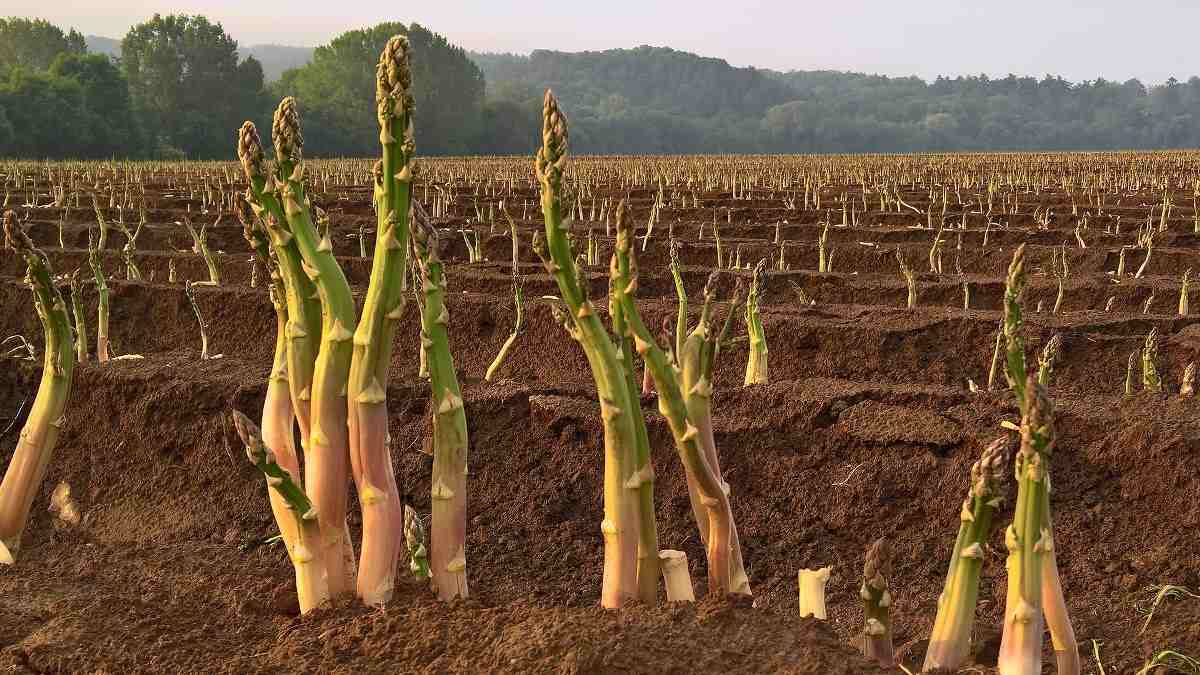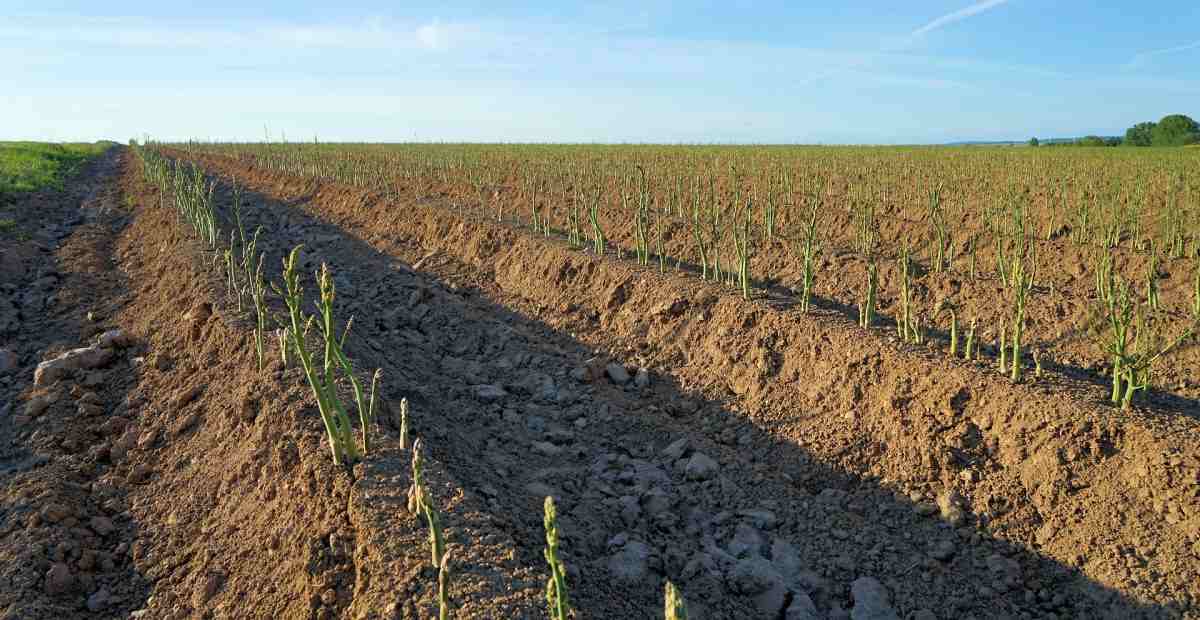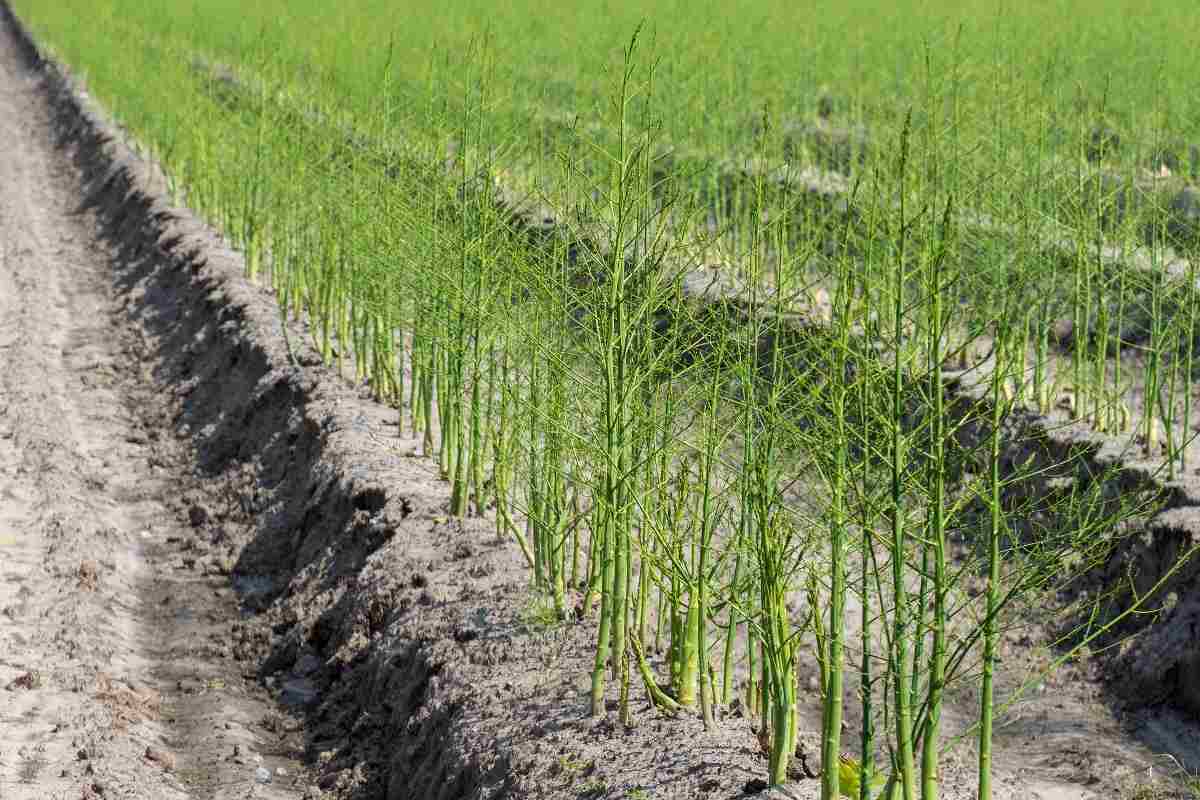Introduction to Organic Asparagus Farming
Organic Asparagus is a valuable crop and one of the earliest spring vegetables. Asparagus has few disease or pest problems and can be grown without artificial pesticides, making it a relatively easy crop to grow organically. Good weed management, especially during establishment, is essential to promote healthy growth and satisfactory quality and yield.
A Step by Step Guide to Organic Asparagus Farming
Organic Asparagus is produced using pest management and fertilization methods that do not contain synthetic compounds. Like other vegetable production systems, Organic Asparagus production involves developing a functional system that provides suitable fertility while maintaining effective weed management.

Organic Soil Preparation for Asparagus Farming
To grow organic Asparagus as a perennial, it’s important to plant from seed in loose soil. Organic Asparagus loves sandy well-drained soil. Combine a 50/50 mix of compost and sand to prepare the perfect soil. You must amend and carefully fertilize soil once before planting. Fertilizing and amending every year would involve disrupting the crown and roots of the plant and is not recommended. To establish the deep root system needed for it to produce a harvest year after year, till the soil a foot deep. This way, the soil can insulate the plant through frost and winter. Soil pH value should be neutral (between 6.5 to 7.5). Growing organic Asparagus means producing this delicious and nutritious vegetable without the use of synthetic fertilizers or pesticides. Provide as much sun as possible and a sandy, fast-draining soil for the plants. Poor drainage will cause the roots to rot. Keep roots 12-18 inches away from fences and sidewalks. Beds will fill in over the years. Many backyard gardeners with space imitations use asparagus as a border or hedge plant. Asparagus does not compete well with weeds and mulch the bed well with organic compost, well-aged manure, leaves, or straw and pull any weeds that may appear.
Prepare the planting area well in advance of ordering your asparagus crowns, so the site is ready when they arrive. Asparagus grows best when it is planted in deep, well-drained soil filled with the essential plant nutrients and trace minerals. The best way of achieving this is by digging-in a 2 inch (5cm) layer of organic compost into the planting bed before you plant your asparagus crowns. Another way of organically improving the soil in advance is to grow a soil-building cover crop. The fall before you plant your asparagus, plant the site with nitrogen-fixing bell-beans, vetch, or peas mixed with oats or another grass. The grass will act as a scaffold for the legumes and will provide organic matter, and the legumes themselves will add nitrogen and other nutrients to the soil. When the cover crop begins to flower, cut it down and mix it into the soil. Asparagus plants especially like phosphorus. You can add phosphorous to the planting area just before you set out the crowns by mixing bone meal or rock phosphate into the soil at the bottom of the planting trench.
Organic Asparagus grows in a wide variety of soils but grows best in a light well-drained soil with rich nutrient content. Deep alluvial soils offer optimum conditions for growth. Though, these soils can be prone to erosion, low in organic matter, and maybe leached of essential nutrients. The soil must be analyzed for its nutrient status well before planting to determine pre-planting nutrient requirements and a fertility program must be implemented at least two years before planting. If a green manure crop is to be grown as part of the fertility program it will need incorporation well before planting so that organic residues are properly decomposed. Compost is an excellent soil amendment and must be considered an important addition pre-planting, with annual applications for the established Asparagus stand.
Site Selection for Organic Asparagus Farming
Only land that has been free of prohibited substances (e.g. artificial fertilizers and synthetic pesticides) for 3 years can be certified for organic production. A well-maintained organic Asparagus planting can continue to produce for 10 to 15 years. Because of this crop’s longevity, it is especially important to be selective in selecting an appropriate planting site for organic production. Select a rock-free site and relatively level, with light to medium-textured loam soil where Asparagus has never been grown. Organic Asparagus is susceptible to Fusarium, so do not plant in sites where Fusarium has been known to be present. Soils must be deep and without a hardpan. A good drainage system is essential for this; Organic Asparagus will survive short periods of flooding, but not prolonged waterlogged soils. Because Organic Asparagus is a poor competitor with weeds, it is also critical to avoid fields where aggressive perennial weeds have a history of being difficult to manage. Two full seasons before planting must be devoted to site preparation. This will include adjusting fertility, soil build-up, and weed management. Soil fertility can be improved through cover crops, green manure, nitrogen-fixing legumes, animal manure, and approved natural fertilizers. Green manure crops must be fully decomposed before setting crowns.
You should not miss this: Organic Avocado Farming, Cultivation Practices.

Sunlight Needed for Organic Asparagus Farming
Organic Asparagus needs 6 to 8 hours of sunlight. If you are planting in a space that leans on the brighter side, make sure to apply mulch throughout the year to protect the soil from drying out between watering. Organic Asparagus will grow wild in areas that have heavy overhead foliage. They thrive in beaches, ditches, and along bluffs where the water comes from runoff and gathers, but also the surroundings protect from the hot sun.
The Seed Rate of Asparagus
Organic Asparagus can be propagated through seeds, crowns, and seedlings but the most commonly followed practice is through seeds only. It needs about 3 to 4 kg seed for cultivation in one hectare.
Asparagus Seed Germination Process
Asparagus seeds are good for up to 3 years after you’ve initially purchased them. To get organic Asparagus seeds to germinate more quickly for planting indoors, pre-soak them in water or a compost tea. Once you have soaked Asparagus seeds, plant them immediately in flats or individual pots. The best soil temperature for germination is about 21 to 24 °C. They should come up in about 10 to 12 days at this temperature. Organic Asparagus seeds will germinate in 53 days at 10°C, 24 days at 15°C, and 15 days at 20°C. Germination times begin to increase above 25°C. If you’re planting seeds in your garden, the best temperature range for your soil is around 16 to 18°C.
How to Plant Asparagus Crop
Choose a site with fertile soil that’s clear of perennial grasses and weeds. A single row of Asparagus plants set around 15 inches apart will fill in to form a 24- inch-wide bed, or you can grow a double row in a 36-inch-wide bed. Locate Asparagus along the side or back of your garden, as 5-foot-tall Asparagus fronds will shade any nearby plants. A bed of 25 mature plants will yield about 10 pounds of Asparagus per year.
Organic Asparagus craves phosphorus, which is generally abundant in composted manure and compost made from kitchen waste. Add a 2-inch layer of weed-free, rich compost to your soil before planting. Dig a trench around 4 inches deep and around 10 inches wide in the amended soil and arrange the crowns in the bottom, about 15 inches apart. Top-up the trench without stepping on the bed. Organic Asparagus production needs the use of certified organic planting stock that has not been treated with synthetic materials. Because it is hard to find certified seed or crowns, organic growers need to plan at least 2 years before the desired planting date when purchasing planting material. The organic certification program, site preparation, and soil testing must be completed before any planting material is ordered. 7,000 to 9,000 plants are needed per acre with 1-foot plant spacing and 5 to 6 feet between rows.
You may also check this: Organic Cucumber Farming In Greenhouse.

Organic Asparagus is planted in the spring. The simplest method is to plant one-year-old crowns. It is important to lay down ground solid before growing Asparagus for the 1st time. Even though the young crown will appear to be a lifeless mass of roots, it will begin to send up small green shoots shortly after planting. Set Asparagus plants 18 inches apart in rows 5 feet apart. Spread the roots in the bottom of the trench or hole and cover the crown with about 2 inches of soil. The tops of the crowns must be around 6 inches below the soil surface when the trenches are filled. This allows for cultivation by tiller or hoe and also provides an adequate depth of soil for the new buds to develop on top of the crown. The alternative to using one-year-old crowns is to start Asparagus transplants from seeds as you would start other vegetable transplants. About 6 to 8 weeks before planting, sow the seeds directly into pots. Thin to one plant per pot and, after all, the danger of frost has passed; plant the young seedlings as described above for crowns.
Organic Fertilizers and Manures for Asparagus Farming
Organic fertilizers are minimally processed, naturally occurring compounds that provide plants with nitrogen, potassium, phosphorus, and trace minerals. Some readily available organic fertilizers are;
- Blood meal (nitrogen)
- Bone meal (phosphorus)
- Rock phosphate (phosphorus)
- Granite dust (potassium, calcium, and magnesium)
- Kelp meal (trace minerals like zinc)
Whatever fertilizer you use, be sure to read the package and apply it as directed.
Fertilize your asparagus bed by side-dressing the plants in the early spring in the first year of growth. Organic manures like Vermi-Compost, Farm Yard Manure (FYM), and Green Manure, etc. may be used as per the necessity of the species. To prevent diseases, prepare bio-pesticides (either mixture or single) from Neem, Cow’s urine, Datura, etc. Fertilize organic Asparagus again in early summer after you have stopped harvesting spears. You can top-dress with a balanced organic fertilizer, or scatter another inch of weed-free, rich compost over the decomposing mulch. Commercial organic fertilizers that can supply most nutrients are available, but these should be carefully evaluated for effectiveness and cost. Some organic certification organizations have approved a range of commercial organic fertilizers.
Keep organic Asparagus patch performing well by top-dressing every spring with 2 to 3 inches of composted manure, followed by a 2-inch layer of loose organic mulch. Shredded arborist’s woodchips, straw, and finished compost are all good choices. This top-dressing will provide the soil with phosphorus and nitrogen; also keep it weed-free and in good tilth. Organic Asparagus loves phosphorus. Bone meal, composted manure, and rock phosphate are all good amendments to maintain soil levels high in this nutrient.
Organic Asparagus is a relatively heavy feeder. While the spring top-dressing will feed and add some organic matter to the organic Asparagus patch, you will get better results if you feed lightly in early spring and again in the middle of the summer with a high-phosphorus organic fertilizer, like fish meal, which has a typical N-P-K value of 8-12-2.
How to Control Weeds in Organic Asparagus Farming
Weed control is a major problem facing organic Asparagus producers. Since organic Asparagus is a perennial crop that increases in bed-width each year, cultivation for weeds “in the row” during spear harvest, and following harvest during fern production, is not possible. Therefore, elimination of perennial weeds such as quack grass, bermudagrass, johnsongrass, and nutgrass before planting is particularly critical. Annual weeds can be controlled through a combination of mechanical, cultural, and biological control techniques.
Water Management in Organic Asparagus Farming
Organic Asparagus is very deep-rooted and draws water from a large volume of soil. This allows the crop to withstand considerably more dry weather than other shallow-rooted crops. Deep rooting also permits longer intervals between irrigation applications, rather than other irrigated crops. Successful organic Asparagus production will need irrigation for maximum yields. Irrigation is significant to relieve drought stress, particularly during the first 2 seasons after crown planting. Dry weather during the cutting season or late in the fern growing season will have little effect on yield. An extended dry period early in the development of the fern after the cutting season is undesirable and may decrease yield the following year. Remember, drought stress on the crop decreases fern growth, therefore reducing potential future yields. Organic Asparagus may be irrigated by 3 methods: Sprinkler, drip (trickle), or furrow irrigation. Sprinkler irrigation wets the foliage and can cause more disease problems due to soil splash. Sprinkler irrigation also washes off spray residues if the crop is being sprayed for disease or insect control.
Organic Pest Management in Asparagus Farming
Pest management in organic fields emphasizes prevention through cultural practices and good production. Monitoring pests through regular crop inspections and correct identification are important to keeping ahead of potential problems. The goal is not the complete elimination of a pest but rather the management of diseases and pests so that crop damage is kept within acceptable economic levels.
Pests – The worst insects for organic Asparagus are the spotted Asparagus beetle, the Asparagus beetle, and the Asparagus aphid. Insect pests include Japanese beetles, Asparagus beetles, cutworms, and aphids. Organic insect management strategies include controlling nearby vegetation, sanitation, insecticidal soap, natural predators or parasites, and organic insecticides.
One more significant challenge for organic Asparagus growers is weed control. Pre-planting plans include selecting sites with low weed pressure, tillage, and the use of smother crops. While intensive weed control is particularly important during establishment when weeds can easily out-compete the young crop, following good weed management practices during the life of the planting is also important. Mowing and cultivation are methods of reducing weed problems after planting; care must be taken to not damage crowns with equipment. Living mulch between rows offers an alternative method for weed management. Composted wood chips, pine straw, or weed-free straw can be used as mulch to aid in weed suppression within rows. Once the mulch is applied, weeds will have to be detached by hand because machine cultivation will not be possible within rows. A small nursery hoe is more beneficial for getting between ferns than a standard row crop hoe.
In an organic Asparagus farming, organic pyrethrins are also effective against the Asparagus beetles. If you have a small patch, you can patrol your patch daily and pick the little buggers and their eggs by hand and drop them in a pail of soapy water. You can also introduce natural predators such as the ladybug larvae or chalcid wasp. Several organic sprays can be used effectively to control thrips including soap, natural pyrethrum, and horticultural mineral oils.
Harvesting Techniques of Asparagus
The harvest period in a mature Asparagus planting lasts about 8 to 9 weeks. Spears are handpicked by snapping them just above the ground. Most growers build their harvest aids to improve harvest efficiency. The asparagus crop is usually harvested by snapping versus cutting. Snapping has the advantage of harvesting an “all usable” product. The spear snaps at the point where fiber starts to develop and Cutting spears below the soil with a knife adds more weight to the spear but the lower one-third of the spear is tough and fibrous and has to be discarded. Also, cutting below the soil damages other potential buds that will send up new spears on the crown. Snapped Asparagus must command a higher price than cut Asparagus.
In case if you are interested in this: How To Make Money From Organic Farming Business.
Thank you sir for your valuable inputs on agriculture.
May I get some information about the treatment of saline groundwater to improve the yield of crops. The groundwater TDS is 4200 ppm and Sodium salts of 3200 ppm contribute very negatively to our crop. We could take salt-tolerant crops like wheat, barley, mustard, etc one in a year only.